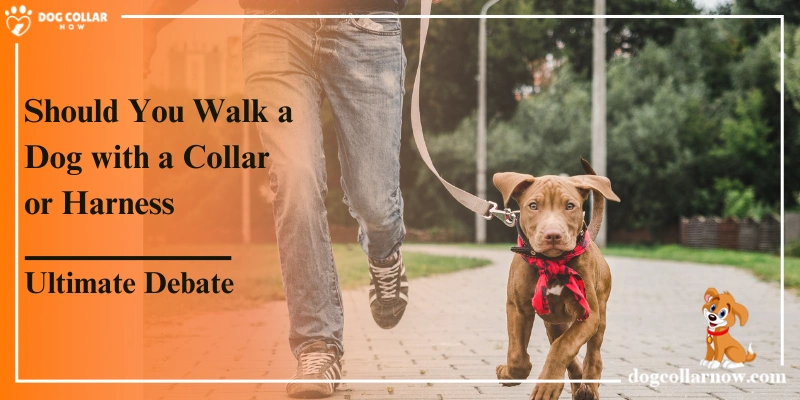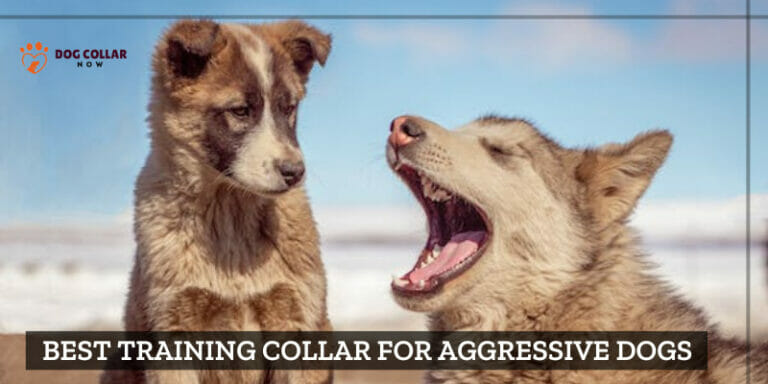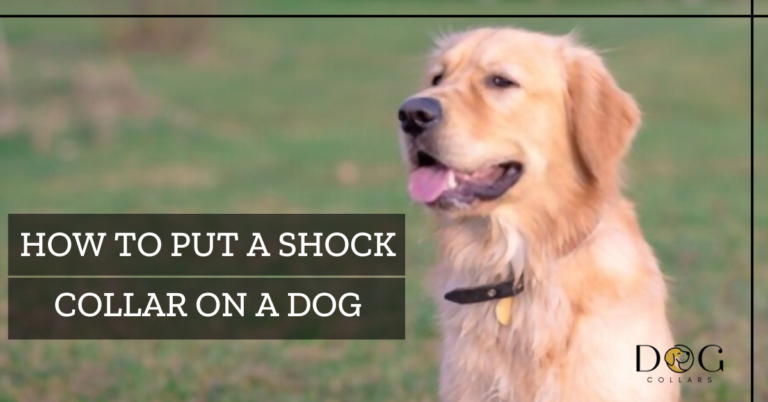Should You Walk A Dog With A Collar Or Harness: The Ultimate Debate

As a pet parent, you want the best for your furry companion, including their safety and comfort while out on walks. One of the most common debates among dog owners is should you walk a dog with a collar or harness. It’s an important decision that can impact your dog’s overall health and well-being.
It depends on your dog’s individual needs and behavior. A collar can be suitable for well-behaved dogs, while a harness may be a safer and more comfortable choice for dogs that tend to pull or have respiratory issues. It’s always a good idea to consult with your veterinarian or a professional dog trainer to determine the best option for your furry friend. Both collars and harnesses have their own importance, depending on the dog’s needs.
Personally, I’ve used both collars and harnesses for my dogs, depending on their individual needs. My Labrador Retriever walks well on a collar, while my Pomeranian mix prefers a harness. When in doubt, it’s always a good idea to consult with your veterinarian or a professional dog trainer to determine the best option for your furry friend.
Now that we’ve explored the basics of using a collar or harness for your dog, let’s dive deeper into the specific benefits and drawbacks of each option.
Should You Walk A Dog With A Dollar Or Harness: Harness Vs Collar
Pros Of Harnesses Walking
Here are the pros of using a dog harness walking
- Better Control And Handling:
Using a dog harness for walking can provide better control and handling, especially for dogs that pull or are difficult to manage. Harnesses distribute pressure evenly across the chest and shoulders, which allows you to control your dog’s movements without causing discomfort or harm to their neck.
- Improved Safety:
A harness can improve your dog’s safety during walks by reducing the risk of slipping out of their collar or leash. Additionally, some harnesses have reflective materials or attachments for attaching a light, which can make your dog more visible in low-light conditions.
- Comfortable And Secure Fit:
When properly fitted, a harness can provide a comfortable and secure fit for your dog. This can be especially important for dogs with respiratory or neck problems, or those that are prone to slipping out of their collars. Some harnesses are also adjustable, making it easier to find the right fit for your dog’s size and shape.
- Versatile Design:
Dog harnesses come in a variety of styles and designs, making them a versatile option for different types of dogs and activities. For example, some harnesses are designed for running or hiking, while others are suitable for everyday walks or training sessions. Additionally, some harnesses have multiple points of attachment for the leash, allowing you to customize the level of control based on your dog’s behavior
Cons Of Harness Walking
Here are some cons of using a dog harness
- Can Be Challenging To Put On:
Putting on a dog harness can be more challenging than attaching a collar, especially if your dog is not used to wearing one. Some harnesses require multiple steps to secure, which can be time-consuming and frustrating if you’re in a hurry.
- Can Cause Discomfort Or Chafing:
Some dogs may find wearing a harness uncomfortable, especially if it’s poorly fitted or made from low-quality materials. Harnesses that are too tight or rub against the skin can cause chafing or irritation, leading to discomfort or even injury.
- Restricted Range Of Motion:
Some types of dog harnesses can restrict your dog’s range of motion, making it more difficult for them to move freely during walks or other activities. This can be especially true for harnesses with front attachments, which can limit the movement of the shoulders and chest.
- May Not Be Suitable For All Dogs:
While dog harnesses can be a great option for many dogs, they may not be suitable for all breeds or sizes. For example, dogs with short snouts may have difficulty breathing in certain types of harnesses, while larger breeds may require heavy-duty harnesses to accommodate their size and strength
Pros And Cons Of Dog Collar Walking
Pros Of Collar Walking
Here are some pros of using a dog collar
- Easy To Put On And Take Off:
A dog collar is easy to put on and take off, making it a convenient option for quick walks or potty breaks. This can be especially true if your dog is cooperative and doesn’t mind wearing a collar.
- Lightweight And Unobtrusive:
Dog collars are lightweight and unobtrusive, which can be beneficial for dogs that don’t like the feeling of wearing a harness or other gear. Additionally, collars can be a good option for dogs that have short hair or sensitive skin, as they are less likely to cause irritation or discomfort.
- Can Be Personalized:
Collars can be personalized with identification tags or other accessories, making it easy to identify your dog and ensure they are safe if they become lost. Some collars also come in a variety of colors or patterns, allowing you to express your dog’s personality and style.
- Suitable For Training:
Dog collars can be a useful tool for training and behavior modification. For example, a choke chain collar can be used to discourage pulling, while a flat collar can be used for basic obedience training.
- Can Be Less Expensive:
Compared to some types of harnesses, dog collars can be less expensive, making them a budget-friendly option for pet owners.
Cons Of Collar Walking
Here are some cons of using a dog collar
- Limited Control And Handling:
Using a collar for walking can provide limited control and handling, especially for dogs that pull or are difficult to manage. Collars put pressure on the neck and throat, which can cause discomfort or injury if not used properly.
- Risk Of Injury:
Collars can pose a risk of injury, especially if they are too tight or used incorrectly. For example, dogs that pull on their leash while wearing a collar can experience respiratory problems, neck injuries, or even fainting.
- Not Suitable For All Dogs:
Collars may not be suitable for all breeds or sizes of dogs. For example, dogs with respiratory or neck problems may require a harness to prevent injury or discomfort.
- Limited Functionality:
Dog collars have limited functionality compared to harnesses, which can be a disadvantage for certain activities or training sessions. For example, collars are not ideal for running or hiking, as they can restrict a dog’s movement and make it more difficult to control them.
- Can Be Lost Or Removed:
Collars can be lost or removed, which can be a safety concern if your dog becomes lost or escapes from your yard. Additionally, some dogs may be able to slip out of their collar, which can be dangerous if they run into traffic or other hazards.
How to Tell if Your Dog Needs a Harness or Collar?
There are a few things to consider when deciding whether your dog needs a harness or collar for walks. If your dog pulls on the leash, a harness may give you more control and prevent your dog from getting away. If your dog is very small or has a delicate neck, a collar may be the best option to avoid hurting them.
You should also take into account what type of activities you’ll be doing with your dog – if you’ll be running or hiking, a harness may be a better choice than a collar. Ultimately, it’s up to you to decide what’s best for your dog based on their individual needs.
Safety Tips for Walking Your Dog with a Collar or Harness
Here are tips :
- Make sure the collar or harness is fitted properly and is not too loose.
- Check the condition of the collar or harness regularly, and replace it if it shows signs of wear and tear.
- Be cautious of using a retractable leash with a collar or harness, as the sudden release of tension can cause injury.
- Never leave your dog unattended while wearing a collar or harness.
- Keep an eye out for signs that your dog is uncomfortable or unhappy while wearing a collar or harness, such as excessive panting or licking.
- If your dog shows signs of discomfort, remove the collar or harness immediately.
Conclusion
Walking your dog with either a collar or harness can be beneficial, depending on the size and breed of your pup. While both have their own advantages and disadvantages, it’s important to remember that no matter which option you choose, safety should always come first. Therefore, it is essential that you take into consideration factors such as your pup’s size and behavior before making a decision about whether to use a collar or harness for daily walks. With this knowledge in hand, finding the right solution for you and your furry friend will become much easier!
Frequently Asked Questions (FAQs)
Is it better to walk a dog with a collar or harness?
A harness is recommended as it distributes pressure evenly and reduces strain on the neck. However, note that harnesses may not have an ID tag, but many now have built-in or attachable ones. Harnesses can also be helpful for dog training, providing more control and easier redirection.
Is it better to walk a dog on a harness?
When it comes to walking your dog, it is generally better to use a harness instead of a collar, especially for puppies and certain dog breeds. Harnesses are designed to distribute pressure evenly across the chest and shoulders, which can reduce strain on the neck and prevent injury.
Is it bad to pull on a dog’s leash with a harness?
Using a harness is generally a better option than pulling on a dog’s leash, particularly if you want to train your dog to walk on a leash without pulling.
Pulling on the leash can encourage your dog to pull back, especially if you have a large dog, which can be uncomfortable or even painful for them. A front-clip harness can help you maintain better control over your dog and prevent them from pulling.
Is it OK to walk a dog with just a collar?
Whether it is okay to walk your dog with just a collar depends on your dog and their behavior on walks. For some dogs, a collar may be sufficient, but for others, it may be better to use a harness.
Every dog is different, and it’s important to find what works best for them to walk by your side without pulling. It’s especially important to consider using a harness for a new dog or a dog that’s still learning how to walk on a leash. Many dogs benefit from wearing harnesses instead of just collars, as harnesses provide more control and prevent strain or injury around their neck.
What is the safest way to walk a dog?
The safest way to walk a dog is by using a properly fitted collar or harness. Choosing between a collar or harness depends on your personal preference and your dog’s behavior. Both harnesses and collars have their advantages and disadvantages, so it’s important to know the pros and cons of each.
Regardless of which you choose, make sure it fits properly to give you better control and reduce the risk of injury. Your dog should always wear a collar with a tag that has your contact information in case they get lost.






